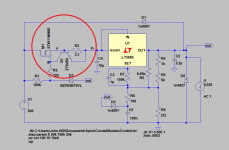Have you considered the LT3081 - it has programmable current limit pin. Seems like a good option.
Implementing a current limit at the IC may not be the best option. It's a sure-fire way of frying the cascode device.
Tom
Does using this regulator with a tube rectifier "solidstate-ify" the rectifier? I know some people like rolling rectifiers for fine-tuning sound out of an amp, and it seems like using an IC-based regulator might mitigate any differences between rectifiers. In other words, is using a regulator like the maida counterproductive when someone is using tube rectifiers for their sound?
I doubt you'll experience any change in sound quality by changing rectifiers if you have a Maida Regulator in place.
Tom
Tom
fwiw, i support Tom and have used his boards. you will probably have to roll your own PCB to incorporate this current limiting idea:
Yes, I ended up modelling a NPN/PNP configuration to cope with limiting but also offer a lower second current value in case of a dead short.
Is there a way to configure the Maida regulator for negative voltage? I need -300V and messed up and built mine for 300V.
I use a Maida reg in my Valve DAC build Sonny, just connect B+ on the Maida board to Ground and Ground on the Maida board is B-.
Works fine for me.
Works fine for me.
Thanks. I wondered about just reversing polarity but didn't want to break anything. And then you use a wire from the Ground input (which has B+ from Maida connected) to the ground loop breaker circuit?
I use a Maida reg in my Valve DAC build Sonny, just connect B+ on the Maida board to Ground and Ground on the Maida board is B-.
Yep! You do need two completely separate secondary windings for that, though. So two windings, two rectifiers, two reservoir caps, two Maida Regulators. Then you connect them as described above and you now have a split supply.
The two secondary windings can be on the same transformer.
Tom
Nautibuoy uses a single Maida in his Valve DAC and apparently wires it up in reverse? Is there a downside to doing it that way?
Nautibuoy uses a single Maida in his Valve DAC and apparently wires it up in reverse? Is there a downside to doing it that way?
Maybe our posts crossed. See my response in Post #609.
The drawback is that you need two separate secondary windings.
Also, the regulators are not connected in reverse. They're connected normally on their inputs to their respective secondary windings, rectifiers, and reservoir caps. They're then connected in series on the output and the centre point is connected to ground. That's exactly the same you would do if you were connecting two batteries to form a split supply.
Tom
Yep! You do need two completely separate secondary windings for that, though. So two windings, two rectifiers, two reservoir caps, two Maida Regulators. Then you connect them as described above and you now have a split supply.
The two secondary windings can be on the same transformer.
Tom
I think you misunderstand Tom, the question/context is not about a dual polarity supply, just a requirement for a negative rail supply. There is no requirement for B+.
In that case, hook the Maida Regulator up to its own secondary winding as described above. Connect the (+) output to ground and take the regulated negative supply from the "ground" connection on the Maida Reg.
Tom
Tom
Would you say an internal heatsink hitting ~80-90C is acceptable for the power MOSFET in the 21CM?
That depends on how much power is dissipated in Q1. In most designs, I'd consider 80-90 ºC to be marginal. I'd try to get down around 65-70 ºC at nominal mains voltage so you have some margin.
Tom
Tom
Thanks, Tom. Power dissipated is around 3.5W, tight space with a dinky heatsink, may have to see if I can upsize to something slightly larger.
For 3.5 W you can probably get away with attaching the MOSFET to the metal chassis (with appropriate thermal pad). If not, then a tiny board mount heat sink will probably do the trick. Beware that many of those are listed by their thermal resistance with forced air flow (i.e. fan cooling). You need to check their data sheets to see the numbers for convection cooling.
Lower temperature is always better for reliability. With that low power there's no reason to run the device at 80-90 ºC.
Tom
Lower temperature is always better for reliability. With that low power there's no reason to run the device at 80-90 ºC.
Tom
Thanks, Tom. Yes, ordinarily I would never be dealing with the issue as the MOSFET would be appropriately heatsinked. However I am adapting a regulator into an existing amplifier, the very successful but poorly designed DarkVoice 336SE tube headphone amplifier. I am doing an overhaul of the design for "fun" for a friend, which makes fitting a regulator tricky given the small chassis. I think I should be able to manage a slightly more capable heatsink with some modifications.
I wonder if you or another forum member might recommend me a text where I could learn about the design of a floating high-voltage LDO regulator like the 21CM? I would appreciate it.
I wonder if you or another forum member might recommend me a text where I could learn about the design of a floating high-voltage LDO regulator like the 21CM? I would appreciate it.
Mike Maida's original app note is pretty insightful. The circuit is also covered in The Art of Electronics.
Tom
Tom
- Home
- Vendor's Bazaar
- 21st Century Maida Regulator
